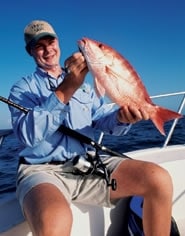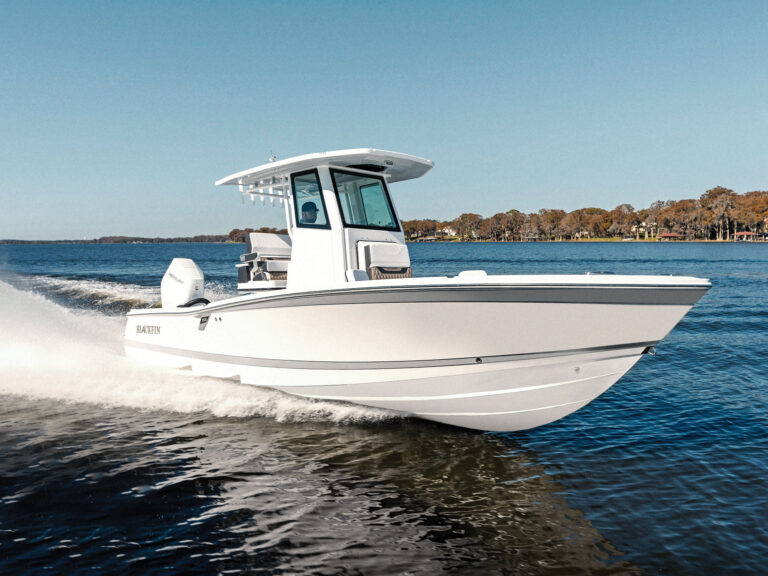
| Richard Schair used a whole icefish to nab this snapper from the nearshore rocks. |
As soon as his 26-foot Mako cleared the Port Mansfield jetties, Captain Frank Vasquez hung a hard left and headed east along the beach. “I’ve got three groups of rocks about 17 miles down the coast,” said Vasquez, a guide with Get-A-Way Adventures Lodge. “It’s a pretty good run, but those rocks hold plenty of red snapper at this time of year.”
When Vasquez finally eased back on the throttles and the boat came off plane, I was stunned. We were no more than two miles off the beach. “You can actually catch snapper this close to the surf?” I asked Vasquez, who was studying his depthsounder intently.
“That’s what we’re looking for, right there,” he said, pointing to a rise on the bottom that had just appeared on the screen. “And yes, you can catch snapper this close in. Lots of them.”
Saved By the State
As it turns out, these nearshore rocks can be the only snapper game in Texas after the National Marine Fisheries Service (NMFS) shuts down the recreational fishery in federal waters (also called the Exclusive Economic Zone, or EEZ), which begin nine nautical miles from shore and extend out to 200 miles. When fishing the EEZ, anglers must abide by the snapper rules set by NMFS.
Inside the nine-mile boundary, however, a different set of regulations apply. Texas law allows anglers to keep four snapper per day, year-round, in state waters. The fish must be at least 15 inches long. According to Hal Osburn, the Texas Parks and Wildlife Department’s (TPWD) coastal fisheries director, the current state regs will likely remain in place for the next few years.
| ### Finding the RocksThe best way to locate the rocks along the South Texas coast is to purchase a copy of Hiltons’ Offshore Atlas, Lower Texas Coast. It features excellent 3-D layouts that offer a detailed view of the bottom. On page 36 of this book you’ll find the GPS numbers to eight rocks off the Port Mansfield jetties. Other maps show rocks out of Port Aransas and on down the Texas coast to Padre Island. Another good source is Hilton’s Offshore Fishing Map – Lower Texas Coast from Port O’Connor to Brownsville. It has all the GPS coordinates for rocks within Texas state waters. For details go to www.hiltonsfishingcharts.com., or call (281) 431-0925. – Robert Sloan |
Running the Rocks
The best snapper fishing in state waters occurs from Port Aransas to the Mexican border. Just about all that fishing is done over rocks, and one of the best areas to find those rocks is the section of coast from Port Aransas down to Port Mansfield.
Prime water depth is 48 to 96 feet, according to expert Ted Caryl of Houston. “The rocks east of Port Mansfield offer some of the best snapper fishing anywhere in Texas,” states Caryl. “When NMFS closes the federal waters, those rocks are about the only place you can legally catch red snapper.”
Caryl’s favorite rocks are located nine to 12 miles east of the Mansfield jetties. He notes that one isolated set extends from the beach out to about 12 miles offshore. They’re called the “north rocks,” and they hold a lot of snapper.
The “rocks” in question are actually living coral formations. They attract lots of marine animals, which in turn draw predators such as snapper, ling, kings, bonito, sharks and the occasional grouper. Caryl says the unique thing about the Mansfield rocks is that they are within easy range of small boats, and almost always hold snapper. “If you don’t find fish on one rock, try another,” he advises. “Sooner or later you’ll find the snapper, as well as other fish.”
There are two reasons why the rocks on the lower-Texas coast hold so many snapper. One is that, unlike the upper-Texas coast, the bottom drops off very fast – in some areas you can be in 40 feet of water just a few miles out. The other reason is that not many people fish them. In fact, it’s rare that you’ll see more than a couple of boats working the rocks on any given day, especially from October through April.

Shakespeare Fishing Tackle’s Larry Tankersley caught this snapper on a rock in 48 feet of water – proof that good fishing is available in state waters throughout the year.|
Surface-Feeding Snapper
This is not your typical snapper fishery, in that it takes place in relatively shallow water. And that can make for some very exciting action, because you can often chum the fish right to the surface.
Last October, my friends and I had excellent success with chum while fishing out of Port Mansfield. We left port with a 100-pound box of whole, frozen pogies (menhaden), the ideal chum for snapper. When placed in a Chum Churn – a commercially available chum-dispenser – the pogies break up into thousands of tiny pieces, producing a fantastic chum line and surface slick.
Prior to the trip, I had acquired the GPS coordinates of several rocks within nine miles of the beach. Better yet, those numbers were provided by Carl Christoph, one of the best giant-snapper anglers in Texas, who had assured me the rocks would more than likely hold some big fish during October and November. He was right.
We started our chumming efforts about seven miles off the beach and a few miles west of the Port Mansfield jetties, in 67 feet of water. With the boat held about 20 yards upcurrent of the rock, we used the Chum Churn to create a stream of pogy tidbits. It wasn’t long before snapper up to 12 pounds were feeding in plain view.
The drill was simple: One person held the boat several yards upcurrent of the rock while another kept the chum flowing to keep the snapper interested. Meanwhile, three anglers pitched jigs tipped with chunks of squid and Spanish sardines to the excited fish.
In this type of sight-casting situation, I often use a spinning outfit. My favorite setup is a Shakespeare Tidewater 4850 reel spooled with 30-pound line and mounted on a seven-foot Custom Ugly Stick rod. This is a perfect outfit for flipping one-ounce jigs (tipped with a piece of squid or shrimp) and lets me deliver quick casts to individual fish in the chum slick. The latter is important if you want to target the biggest snapper, because the smaller ones are a lot faster.
However, sometimes the biggest snapper won’t rise to the chum, and that’s when it pays to fish bottom with a three- to four-ounce jig rigged with a whole bait. Caryl prefers white, arrowhead jigs with white and red nylon tails, and almost always tips them with whole icefish or Spanish sardines. Other productive jig colors include chartreuse/white, blue/white or red/white.
| ### Charters & Info | ||
| * Get-A-Way Adventures Lodge Port Mansfield, (956) 944-4000 http://www.getawayadventureslodge.com ¿ * Capt. Tommy Gueldner Port Aransas, (800) 605-5448 ¿ * For fishing reports, tips and more on snapper fishing, go to http://www.redsnapperfishing.com |
When you combine a four-ounce jig with a whole pogy or sardine, you’ve got a pretty heavy rig. In this situation I’ll use a stout baitcasting outfit spooled with 50-pound test. This rig will easily handle big snapper, as well as the occasional shark, ling or king mackerel that happens along.
Current can be a factor in how you fish the rocks. Maintaining your position over a rock in a ripping current is almost impossible. In this case, you have two options. One is to drift over or around the rock. The other is to anchor. Drifting is usually your best bet, as getting an anchor to bite on a hard sand bottom is tough, if not impossible, in a strong current.
If I’m fishing in 50 feet of water or less, I’ll often turn the engines off as I drift, as snapper can be awfully spooky in shallow water. I also mark the rock with a buoy so I know exactly where to set up my drift to cover all parts of the structure.
Snapper fishing over the rocks in the fall and winter provides some of the best action of the year – and you don’t have to run far to enjoy it. The fish aren’t giants, but you’ll almost always catch plenty of them.









